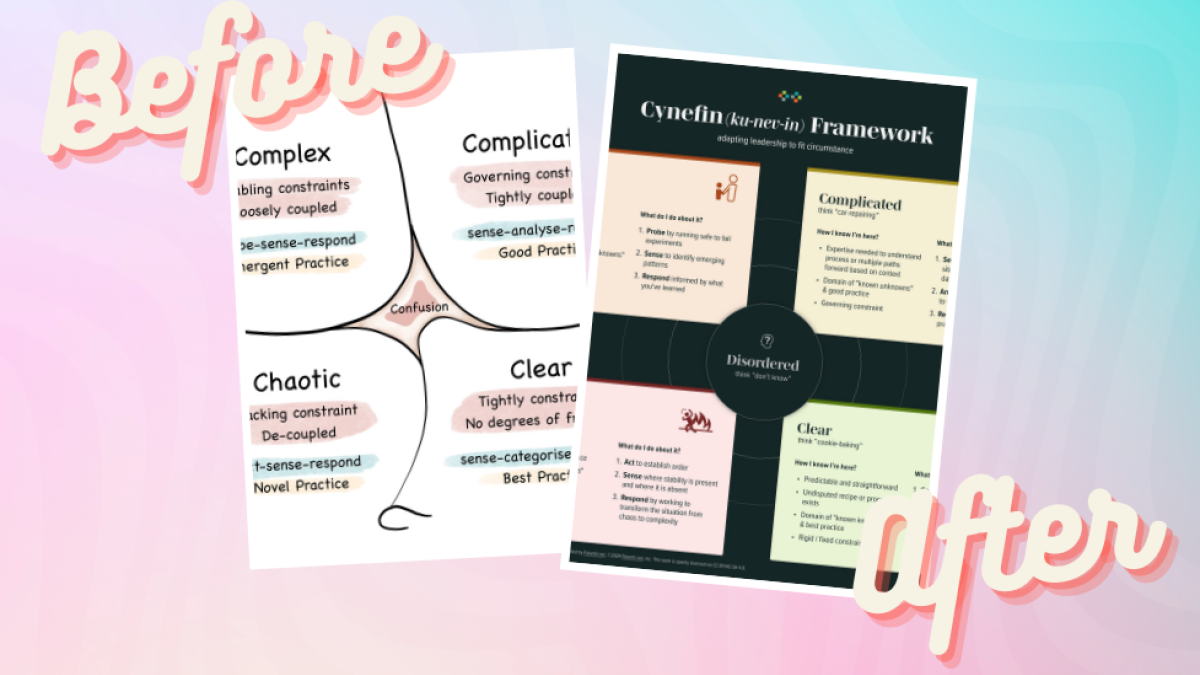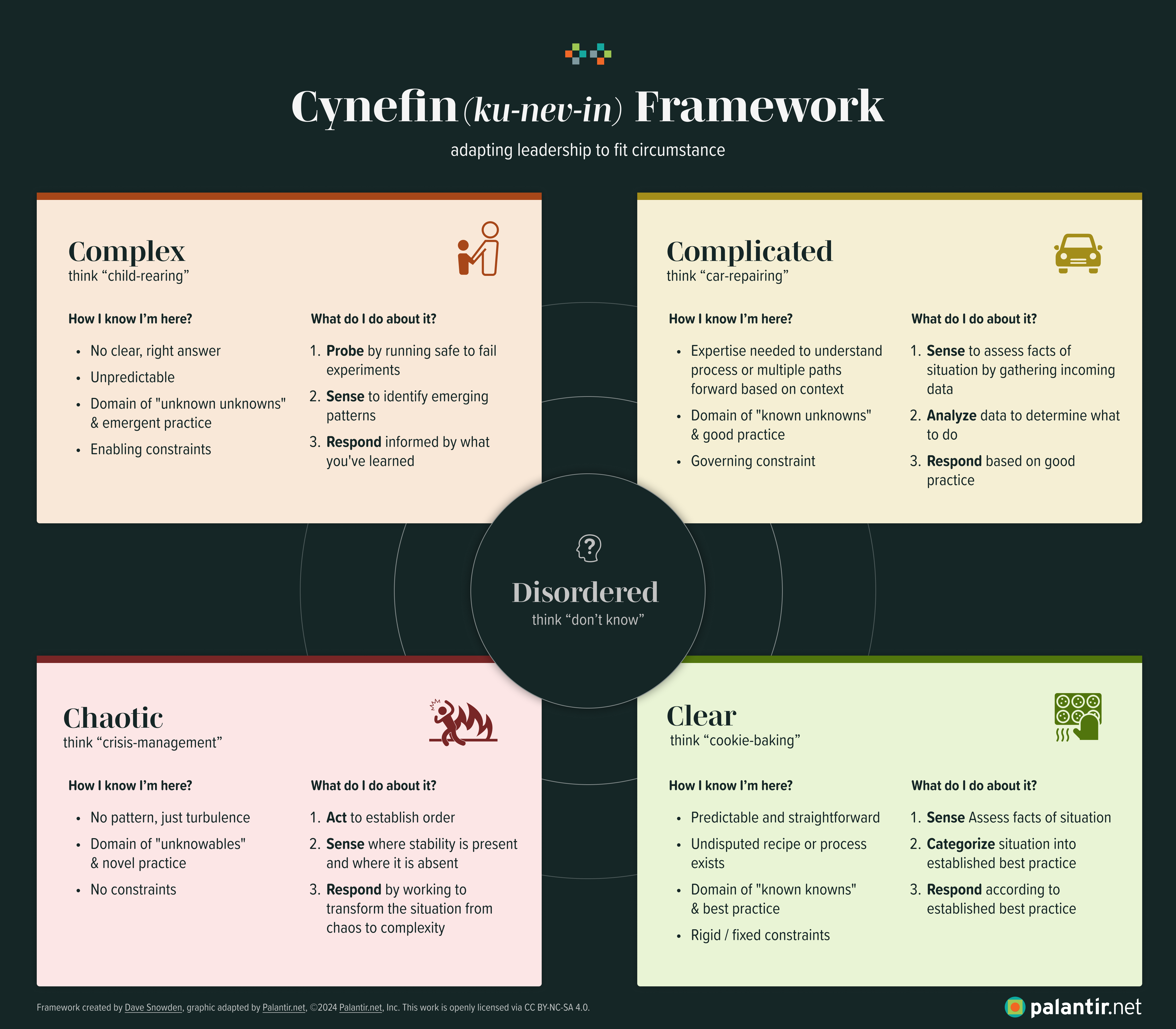Making sense of Cynefin (to be a more adaptive leader)
How we made a complexity framework less complicated

Strong leaders adapt as their circumstances change. As a consultancy whose clients have complex business needs, we find value in the Cynefin framework. While Cynefin is useful, it can be challenging for people to learn. I saw this as an opportunity for some UX improvements to make Cynefin more approachable. Read on to become a more effective leader, as circumstances shift around you, and to find inspiration to iterate your world.
Cynefin 101
Let’s start by introducing the Cynefin framework for those who aren’t already familiar with it.
The Cynefin framework has been around since 1999. It divides the context for leaders’ decision-making into five distinct domains: clear, complicated, complex, chaotic, and confusion.
Here’s how the framework visually represents and describes each domain:

- Clear: tightly constrained, no degrees of freedom, sense-categorize- respond, best practice
- Complicated: governing constraints, tightly coupled, sense-analyze-respond, good practice
- Complex: enabling constraints, loosely coupled, probe-sense-respond, emergent practice
- Chaotic: lacking constraint, de-coupled, act-sense-respond, novel practice
- Confusion: the space between the other domains, for when we don’t know which domain we’re in
That bulleted list captures the entirety of what’s available within the framework itself. There are deeper-dive descriptions in the Harvard Business Review, UX Collective, and elsewhere online.
After reviewing many resources on this framework, I still struggled to internalize and use it. Many of my colleagues shared my experience. So, I put on my UX Strategist hat to investigate how I might make Cynefin more usable.
Thanks to Palantir’s invitation to spend discretionary time on ideas that energize us, I had capacity to examine the Cynefin framework. I noticed that it includes labels and structural elements that make it difficult to learn.
Cynefin can be confusing
For English-speakers, “Cynefin” isn’t pronounced phonetically. Unless you’ve learned how to pronounce it (perhaps you speak Welsh or are one of the 13,000+ people who have watched “How to Pronounce Cynefin” on YouTube), you will pronounce it incorrectly. This makes new learners of the framework more vulnerable to embarrassment.
Here’s an example. A more commonly-used, non-English word that’s been making the rounds is “hygge”. It’s a Danish/Norwegian word for coziness. I recently read a book about hygge that conveniently included the phonetic pronunciation (HOO-GA). This was so invaluable, as I’ve heard many people struggle through conversations about it.
It’s not just the framework’s name that can be an obstacle to people learning it. It looks like the domains are plotted on two meaning-filled axes. While the horizontal axis moves from unordered to ordered, the vertical axis does not offer meaning. The words within the framework are useful as a reference, but likely only for people who are quite familiar with it. Rather than speaking in plain language, Cynefin expects the user to understand its world of governing vs. enabling constraints and emergent vs. novel practice.
And, then there’s the words of the domains themselves. After much digging into this framework, I still struggle to distinguish between colloquial synonyms. English-speakers often use complicated and complex to describe very similar, if not identical, circumstances. The fact that they all start with the same letter doesn’t help either.
After looking at Cynefin with a critical eye, I saw an opportunity to frame it in a more inclusive way.
A new way to look at Cynefin
I sought to make Cynefin easier to learn and use while keeping its meaning intact. Armed with the pain points we experienced with the framework, I did some research. I sketched a new way of looking at Cynefin, balancing clarity with brevity. My version starts with pronunciation notes, so all English-speakers who encounter it can say it confidently. It then describes what the framework is useful for, “adapting leadership to fit circumstances”. Each domain includes a helpful analogy, as I believe they’re an invaluable shortcut for learning. Each domain also includes concise, yet comprehensive, bulleted lists to understand how to know you’re in that domain and what to do about it. For instance, “Probe” became “Probe by running safe to fail experiments”. Finally, each domain has an associated color. There’s some traffic-light meaning built into the colors I selected. And, the colors could offer another label for each domain. “Do you think we’re in orange or yellow territory now?” makes more sense to me than “Is this complex or complicated?”.
After completing my sketch, I worked with a designer colleague (thanks Ashley!) to create the graphic. Here’s how our version of the framework visually represents and describes each domain:

Clear (think “cookie-baking”):
- How do I know I’m here?
- Predictable and straightforward
- Undisputed recipe or process exists
- Domain of “known knowns” and best practice
- Rigid / fixed constraints
- What do I do about it?
- Sense to assess the facts of situation
- Categorize situation into established best practice
- Respond according to established best practice
Complicated (think “car-repairing”):
- How do I know I’m here?
- Expertise needed to understand process or multiple paths forward based on context
- Domain of “known unknowns” and good practice
- Governing constraint
- What do I do about it?
- Sense to assess facts of situation by gathering incoming data
- Analyze data to determine what to do
- Respond based on good practice
Complex (think “child-rearing”):
- How do I know I’m here?
- No clear, right answer
- Unpredictable
- Domain of “unknown unknowns” and emergent practice
- Enabling constraints
- What do I do about it?
- Probe by running safe to fail experiments
- Sense to identify emerging patterns
- Respond informed by what you’ve learned
Chaotic (think “crisis-management”):
- How do I know I’m here?
- No pattern, just turbulence
- Domain of “unknowables” and novel practice
- No constraints
- What do I do about it?
- Act to establish order
- Sense where stability is present and where it is absent
- Respond by working to transform the situation from chaos to complexity
Disordered (think “don’t know”)
- What do I do about it?
- Gather more information to identify what domain you’re in.
A new way to talk about Cynefin
What follows is my more inclusive approach to introducing Cynefin.
Without intending to do so, we become creatures of habit. This can mean doing things that worked in the past, whether they fit the current circumstance or not. If you’ve ever worked for a micro- (or absentee) manager, you’ve worked for someone who could benefit from Cynefin. Here’s how. Rather than adapting to what happened in the past, leaders need to adapt to what’s happening right now. I’ll use my own work as an example.
If I’m in the clear domain, I might be helping a user research participant share their screen using a videoconference tool. I have a recipe for what to do here. There’s a right answer that’s fairly common knowledge (especially post-COVID). Therefore, innovation and experimentation isn’t a good use of my energy and could create frustration for the other person.
If I’m in the complicated domain, I might be collaborating with a client on a content audit. While this requires more specialized expertise, it’s still fairly predictable for someone with experience. I will adapt my approach to this circumstance, but I have a “good practice” approach to follow. Another strategist might have a slightly different approach, and that’s normal and expected in this domain.
If I’m in the complex domain, I might be building trust with a new client. Everyone is different, so I can’t count on a previous approach to be successful. Each client has their own unique motivations, communication styles, levels of influence within their organization, etc. So, what I do is try things out. I’ll start a meeting with some small talk and run similar “safe to fail” experiments. From their response, I’ll learn what they need to feel trust in my work. This allows me to adapt appropriately. When I start on a new project, I start the process over again. People are all different, so what resonates with one person may not be the same for another. What works for me also may not work for a colleague with a different personality.
If I’m in the chaotic domain, it’s a rare circumstance. Chaos represents those SOS moments when everything goes out the window. At a previous job years ago, I came to work one morning thinking it was a normal day, only to discover that the company had laid off a third of my team. Those of us that remained spent the afternoon in a conference room figuring out what to do next. At moments like these, there’s no formula to follow. We just need to act to find some stability. Once we aligned on a plan, we shifted from chaos to complexity.
Using Cynefin is as simple as checking our circumstances before responding to them, questioning our instincts. Is it raining outside or sunny? Is it hailing golf balls? Make sure to adapt your response to what’s happening now. This will make you a stronger leader, colleague, and person.
Innovation begets further innovation
In conclusion, we invite you to expand how you innovate! Transform the way your organization talks about Cynefin by using and sharing our graphic. Resist the pull toward complacency with the way things are. If there’s a tool in your world that isn’t quite right for the job, change or adapt it. If you want this growth thinking and comfort in complexity directed at your organization, drop us a line.
Cover image includes modified versions of works by Tom@thomasbcox.com and Palantir.net licensed via CC BY-NC-SA 4.0.
